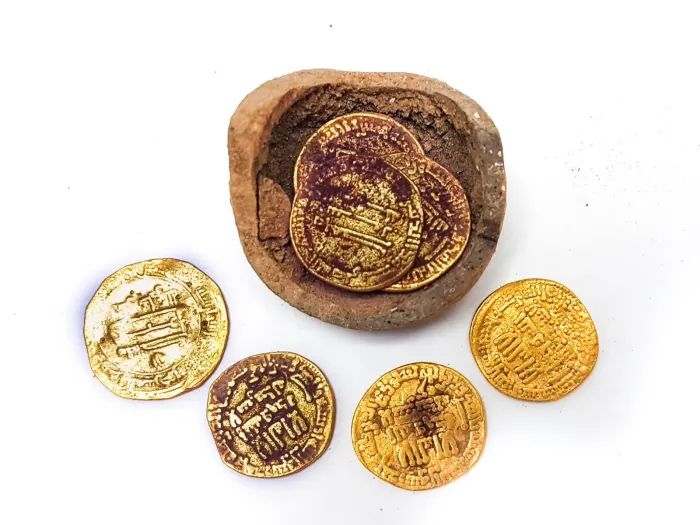
A cache of golden coins from the reign of Haroun al-Rashid was discovered in Yavneh
A cache of 1,200-year-old gold coins was discovered in an archaeological excavation by the Israel Antiquities Authority near the town of Yavneh. In a small clay jug, the excavators discovered seven gold coins. According to the archaeologists, it may have been be the personal savings of a potter whose pottery studio was nearby. The excavations, southeast of Tel Yavneh, were instigated by the Israel Lands Authority as a preliminary investigation prior to construction of a new neighborhood in the town of Yavneh.
The coins in the little jug date from the early Muslim period, in the 9th century. The area where the cache was found was a large industrial zone, full of kilns used for making clay jars, bowls, and other cooking ware, which were sold locally and even exported.
A preliminary examination by Dr. Robert Cole, a numismatic expert from the Israel Antiquities Authority, reveals that the cache dates to the beginning of the 9th-century Abbasid caliphate. One of the coins is a gold dinar from the reign of Harun al Rashid (786-809 CE; the fifth Abbasid Caliph), the ruler immortalized in the tales of A Thousand and One Nights. The Yavne area was the local center of Abbasid rule at that time; the only extant remains from this period in Israel is Ramla’s “Rainbow Pool.”
“The cache contains coins that we rarely see here in Israel. These are golden dinars of the Agalba dynasty – local rulers of the Abbasid caliphate in Baghdad, who ruled North Africa. This is surely a Hanukkah gift for us,” concluded Cole.
In another part of the site in Yavneh, the remains of a vast Persian-era industrial facility (5th-4th centuries BCE), dating back more than 1200 years earlier than the Muslim industrial zone, were apparently used to make wine. According to Dr. Eli Haddad, “In preliminary investigations we found numerous grapevine kernels inside the facility’s chambers. We believe that the size and quantity of these wine production facilities are indicative of commercial-scale wine production, far beyond the local consumption of ancient Yavneh residents.”

